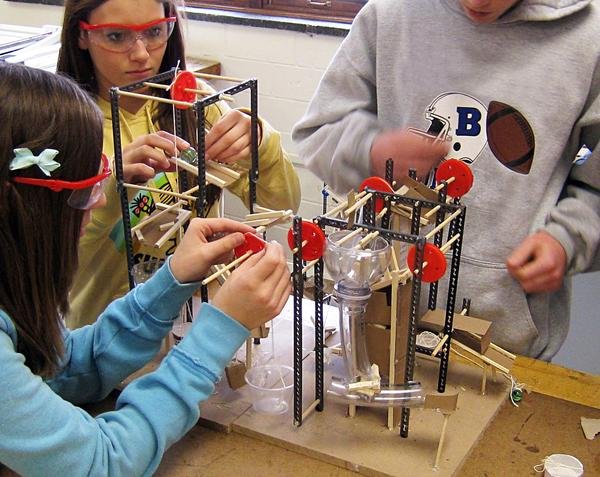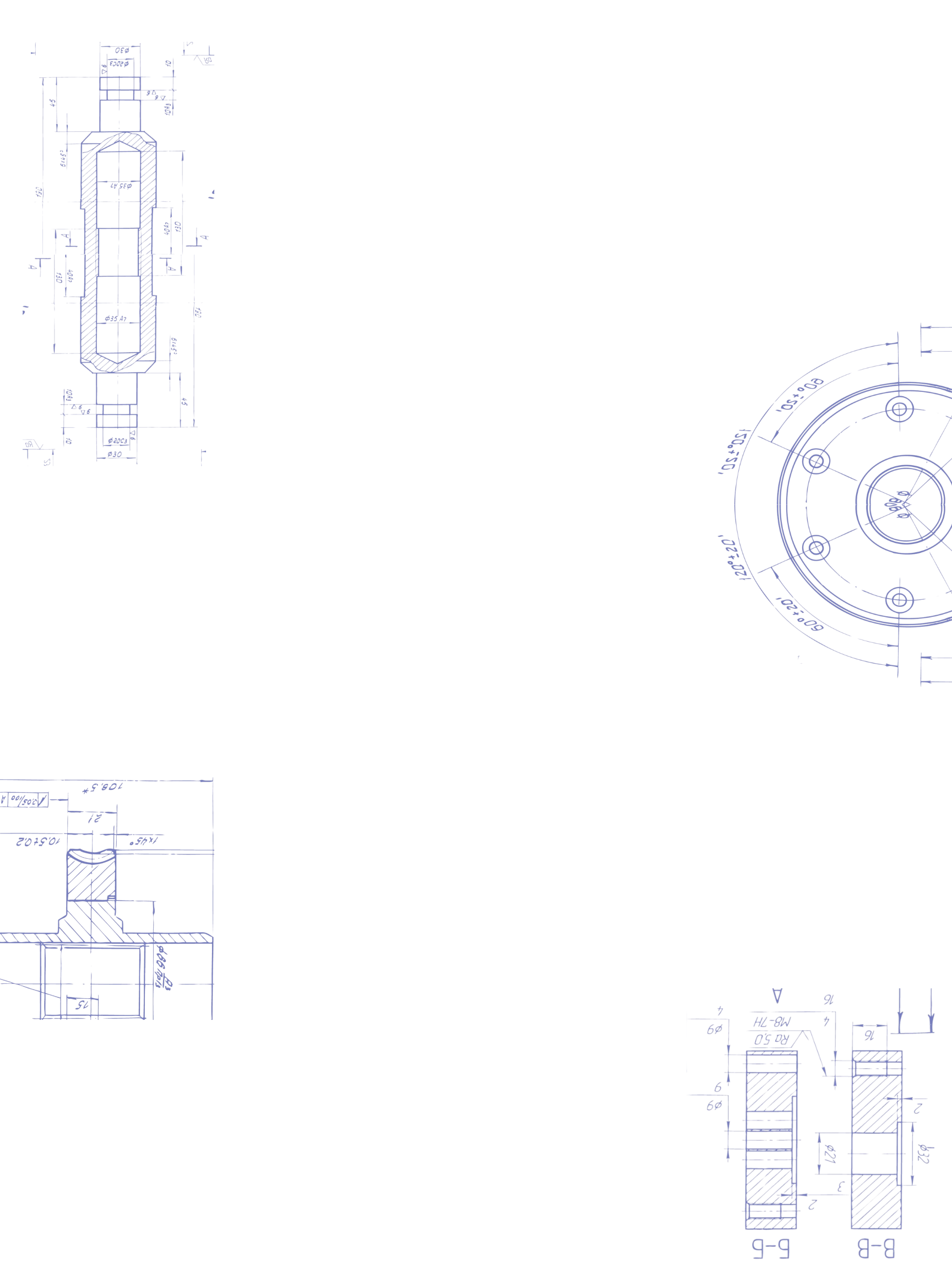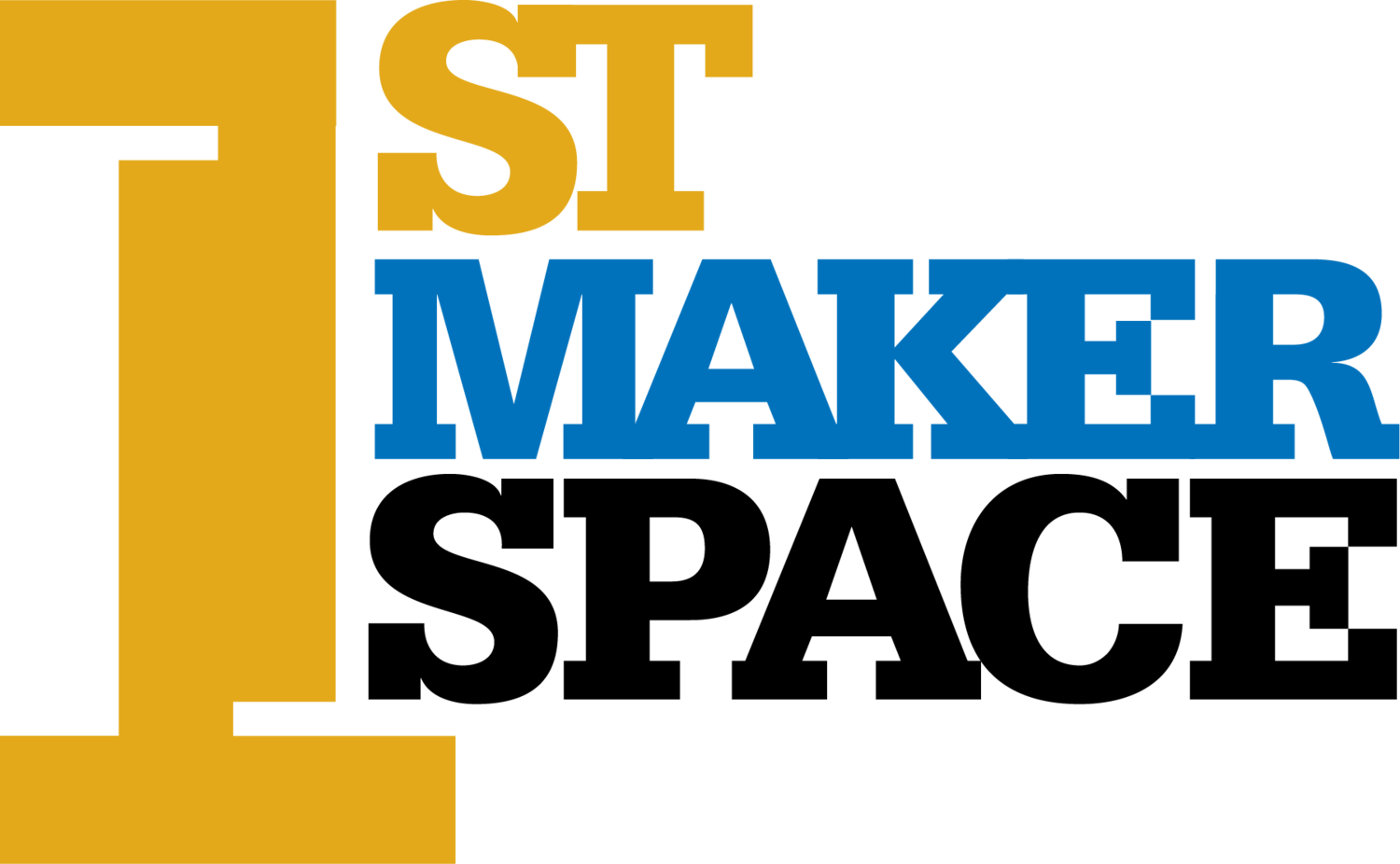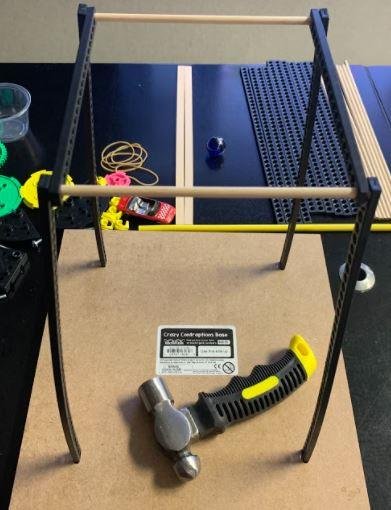
High School Maker Curriculum: Engineering
Crazy Contraptions (Sample)
Length of Time: 6 Days, 55 minutes each day
Grades 9 - 12
Recommended for 9th and 10th Grade
Overview
Students will utilize the different simple machines to allow a ball to move through their crazy contraptions using their knowledge of work, energy, force, rotational motion, torque, and simple machines.
Content
Click a section to skip ahead
Objectives
Students will be able to:
Construct a crazy contraption that completes a task.
Utilize at least four simple machines in the process.
Calculate work, energy, force, rotational motion, and torque at any given point in their crazy contraption.
Make a poster that explains the simple machines on the crazy contraption.
Getting Ready
Materials/Equipment
Crazy Contraptions Kit from 1st Maker Space
Tool Set by 1st Maker Space
Reamer
Philips Screwdriver
Multi-cutter
12” x 12” x 1⁄2” Wooden Base made from Particle Board, MDF, or Plywood (can be purchased or made)
Hot glue gun and sticks
Masking Tape
String
Scrap Paper
Recycled Items
Stopwatch
Triple Beam Balance (optional)
Scissors
Safety Glasses
Vocabulary
Gravity
Force
Weight
Tension
Torque
Newton’s Laws of Motion
Work
Kinetic Energy
Potential Energy
Preparation
Purchase the Crazy Contraptions kit and base from 1st Maker Space or obtain supplies from the TeacherGeek Maker Cart 2.0.
Review the Teacher Quick Start Guide.
Make copies of the Student Guide and Build Guide or make it digitally available.
Display books about Rube Goldberg creations in the classroom (see below for ideas)

Lesson Elements
Engage
(20 minutes)
Students will watch “Rube Goldberg”.
The teacher will lead a discussion to review the video with questions such as:
What makes Rube Goldberg machines so interesting?
What was Rube Goldberg’s significance in society?
How did Rube Goldberg use his engineering background to
engage in societal matters?
Optional: Teacher will introduce the lesson using a Marble Run kit. The teacher will either build a sample Marble Run or challenge students to build a simple marble run.
Exploration
(2-3 days)
The teacher will introduce the Crazy Contraption Build Guide and share the design brief for the project. The teacher will then divide class into groups of 2-3 students each. Each group will collaborate to make their own Crazy Contraption.
Each group will have the following roles:
Engineer (design and calculate using formulas)
Technologist (build device)
Project Manager (create a poster, document steps, and keep the group on track)
Students can self-select their own roles or the teacher can assign roles as needed.
The teacher will share some examples of the different simple machines using the Crazy Contraption PowerPoint.
If needed, students will explore simple machines by creating small versions of simple machines using the materials provided. This can be helpful if simple machines have not yet been explored or if students need additional support.
Students will work with their small group to design a Crazy Contraption using the Student Guide. The goal of the contraption is to complete a task (turn off the light, pop a balloon, etc.). The teacher can specify the task or students can create their own depending on the creativity of the group and time allotted. The teacher can scale down the task to move a ping-pong ball through the machine from start to finish.
Design Criteria:
Transfer energy through a series of mechanisms. Each mechanism will link with the next mechanism to transfer energy from start to finish.
Operate completely on its own, once started.
Fit in the area directly above the 12” x 12” base. It must be free-standing.Be constructed from materials listed on page two of the build guide.
Use four or more simple machines.
Take more than four seconds to transfer energy through its system.
Be safe and not damage any other contraptions.
Students will collaborate within their group to share their individual design and create a group design that follows the above criteria. Students should document their designs using the Student Guide.
The teacher will approve the group design before distributing student materials.
Explain & Make
(1-2 days)
The directions below are an alternative to the Build Guide from TeacherGeek.
Obtain your Crazy Contraption package and base. Open the package.
Make sure you have all the supplies provided in the package. The picture below show the minimum materials needed.
3. Insert 4 connector strips facing the same way into the base.
4. Cut a dowel rod into two 150 mm dowel sections.
5. Cut one connector strip in 1⁄2 to get two 150 mm dowels.
6. Assemble the dowels and connector strips as shown. Dowels should extend 5 mm past the connector strips.
7. Attach the assembly from Step #6 into the connectors for Step #3 as shown. This completes your base for your Crazy Contraption.
8. From this point, experiment with different simple machines that you build and attach them to your frame.
9. Do not be surprised if it doesn’t work the first time. Remember, this is an experiment, and we learn by experimenting.
10. Periodically stop to test your crazy contraption after you use one of the simple machines.
a. Does the ball move through the machine as you planned?
11. How can you make the machine work better to accomplish your task?
12. When finished, test out your crazy contraption.
Elaborate
(1-2 days)
Students will evaluate their crazy contraptions by testing the contraption. It should move from step to step smoothly to complete a task.
Once a group’s Crazy Contraption is functioning, students will then:
Record the time that it takes for the ball to move through the crazy contraption machine.
Complete multiple trials of your crazy contraption.
Does it always work?
If not, why?
Calculate the force being applied in the various stages of the device.
Calculate the work being performed by each simple machine.
Calculate the kinetic and potential energy at three of the different stages of your crazy contraption (this can be modified by the teacher).
Formulas and space for students to run their calculations can be found in the Student Guide.
Students will create a poster that illustrates the steps involved in their Crazy Contraption. The student project manager can complete this throughout the project. This can be done through illustrating the design and labeling the steps OR taking and printing a picture of the Crazy Contraption and labeling the steps.
Finally, students will share their Crazy Contraptions with the class through a gallery walk. Allow students to explore each other’s work.
Evaluate
(45 minutes)
Students will evaluate their own contraption as a group using the rubric provided in the Student Guide.
The teacher will then evaluate each group’s work either through a student-teacher mini-conference or through a post-evaluation conference. The teacher should provide feedback for what the group can do better for the future.
Assessment:
See the rubric in the Student Build Guide.
Extending the Lesson
Challenge the class to complete Option #2 in the design brief and connect the Crazy Contraptions together to complete a task through a series of steps.
Host a Maker Faire or STEM Night to display students’ work.
Have students create a cartoon (see below) to illustrate the purpose of their Crazy Contraption.
Figure 1. A Rube Goldberg cartoon of a self-operating napkin.
Additional Cross-Curricular Connections
History:
How did simple machines provide an opportunity for the expansion of society around the globe?
How did the changes provided by simple machines lead to longer life spans?
Art: Explain how Rube Goldberg machines utilize different artistic styles and materials.
Science: What are other more complex machines that could be added to your crazy contraption that would increase the likelihood of your machine completing the task?

Additional Resources:
Reference Books:
Aronson, Sarah, and Robert Neubecker. Just like Rube Goldberg: the Incredible True Story of the Man behind the Machines. Beach Lane Books, 2019.
George, Jennifer, et al. Rube Goldberg's Simple Normal Humdrum School Day. Abrams Books for Young Readers, 2017.
Goldberg, Rube, et al. The Art of Rube Goldberg: (A) Inventive (B) Cartoon (C) Genius. Abrams ComicArts, 2013.
Perdew, Laura, and Micah Rauch. Crazy Contraptions: Build Rube Goldberg Machines That Swoop, Spin, Stack, and Swivel: with Hands on Engineering Activities. Nomad Press, a Division of Nomad Communications, 2019.
STEM Career Connection:
Academic Standards
Indiana Academic Standards for Physics I Science:
PI.3.1 Understand Newton’s first law of motion and describe the motion of an object in the absence of a net external force according to Newton’s first law.
PI.3.2 Develop graphical and mathematical representations that describe the relationship among the inertial mass of an object, the total force applied, and the acceleration of an object in one dimension where one or more forces is applied to the object and apply those representations to qualitatively and quantitatively describe how a net external force changes the motion of an object.
PI.3.3 Construct force diagrams using appropriately labeled vectors with magnitude, direction, and units to qualitatively and quantitatively analyze a scenario and make claims (i.e. develop arguments, justify assertions) about forces exerted on an object by other objects for different types of forces or components of forces.
PI.3.4 Understand Newton’s third law of motion and describe the interaction of two objects using Newton’s third law and the representation of action-reaction pairs of forces.
PI.3.5 Develop graphical and mathematical representations that describe the relationship between the gravitational mass of an object and the force due to gravity and apply those representations to qualitatively and quantitatively describe how changing the gravitational mass will affect the force due to gravity acting on the object.
PI.3.6 Describe the slope of the force due to gravity vs. gravitational mass graphical representation in terms of the gravitational field.
PI.3.7 Explain that the equivalence of the inertial and gravitational masses leads to the observation that acceleration in free fall is independent of an object’s mass.
PI.4.1 Evaluate the translational kinetic, gravitational potential, and elastic potential energies in simple situations using the mathematical definitions of these quantities and mathematically relate the initial and final values of the translational kinetic, gravitational potential, and elastic potential energies in the absence of a net external force.
PI.4.2 Identify the forms of energy present in a scenario and recognize that the potential energy associated with a system of objects and is not stored in the object itself.
PI.4.3 Conceptually define “work” as the process of transferring of energy into or out of a system when an object is moved under the application of an external force and operationally define “work” as the area under a force vs. change in position curve.
PI.4.4 For a force exerted in one or two dimensions, mathematically determine the amount of work done on a system by an unbalanced force over a change in position in one dimension.
PI.4.5 Understand and apply the principle of conservation of energy to determine the total mechanical energy stored in a closed system and mathematically show that the total mechanical energy of the system remains constant as long as no dissipative (ex. non-conservative) forces are present.
PI.4.6 Develop and apply pictorial, mathematical or graphical representations to qualitatively and quantitatively predict changes in the mechanical energy (ex. translational kinetic, gravitational, or elastic potential) of a system due to changes in position or speed of objects or non-conservative interactions within the system.
PI.5.1 For an object moving at a constant rate, define linear momentum as the product of an object’s mass and its velocity and be able to quantitatively determine the linear momentum of a single object.
PI.5.2 Operationally define “impulse” as the area under a force vs. change in clock reading (time) curve and be able to determine the change in linear momentum of a system acted on by an external force. Predict the change in linear momentum of an object from the average force exerted on the object and time interval during which the force is exerted.
PI.6.2 Describe the slope of the graphical representation of restoring force vs. change in length of an elastic material in terms of the elastic constant of the material, specifically for an ideal spring.
Indiana Academic Standards for Integrated Chemistry & Physics:
ICP.3.1 Develop pictorial and graphical representations which show that a single external applied force changes the velocity of an object, and that when no force acts, the velocity of an object remains constant.
ICP.3.2 Construct force diagrams and combine forces to determine the equivalent single net force acting on the object when more than one force is acting on the object.
ICP.3.3 Distinguish between forces acting on a body and forces exerted by the body. Categorize forces as contact forces, friction, or action at a distance (field) forces.
ICP.3.4 Develop pictorial and graphical representations which show that a non- zero net force on an object results in an acceleration of the object and that the acceleration of an object of constant mass is proportional to the total force acting on it, and inversely proportional to its mass for a constant applied total force.
ICP.3.5 Qualitatively describe and quantitatively determine the magnitude and direction of forces from observing the motion of an object of known mass.
ICP.3.6 Qualitatively describe and quantitatively determine the acceleration of an object of known mass from observing the forces acting on that object.
ICP.3.7 Develop pictorial and graphical representations that show that when two objects interact, the forces occur in pairs according to Newton’s third law and that the change in motion of each object is dependent on the mass of each object.
Indiana Science and Engineering Process Standards:
SEPS.2 Developing and using models and tools
SEPS.5 Using mathematics and computational thinking
SEPS.6 Constructing explanations (for science) and designing solutions (for engineering)
Indiana Employability Skills:
Effective Communication
9-10.LS.1 Write documents for a variety of purposes and audiences using varied media formats.
9-10.LS.2 Able to communicate knowledge and thinking through effective oral presentations.
9-10.LS.3 Create presentation media for a variety of audiences.
Attention to Detail
9-10.LS.9 Complete activities and assignments thoroughly and accurately.
Problem Solving
9-10.LS.10 Able to approach problems with reasoning and logic to hypothesize results.
9-10.LS.11 Able to combine concepts in different ways to create new ideas and innovative solutions.










